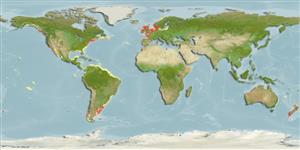Not assigned |
Not assigned |
Phoronidae
Environment: milieu / climate zone / depth range / distribution range
Ecology
Benthic; depth range 0 - 55 m (Ref. 83939). Subtropical
Atlantic Ocean, Pacific Ocean and the Mediterranean.
Length at first maturity / Size / Weight / Age
Maturity: Lm ? range ? - ? cm Max length : 10.0 cm TL male/unsexed; (Ref. 402)
This is a benthic species found on rocky bottoms particularly in intertidal and subtidal areas (Ref. 83938). It is a burrowing and encrusting species inhabiting hard substrates like rocks, empty mollusk shells, Caryophyllia and Lithothamnion (Ref. 402).
Life cycle and mating behavior
Maturity | Reproduction | Spawning | Eggs | Fecundity | Larvae
Members of the phylum Phoronida are mostly hermaphroditic. Life cycle: Embryos develop into free-swimming planktotrophic actinotrocha larvae which later sinks to the bottom and metamorphose into benthic adults.
Hansson, H.G. 1999 NEAT (North East Atlantic Taxa): South Scandinavian marine "Lophophorata" Check-list. Internet. Pdf Ed., Feb. 1999. http://www.tmbl.gu.se (Ref. 997)
IUCN Red List Status
(Ref. 130435: Version 2025-1)
CITES status (Ref. 108899)
Not Evaluated
Not Evaluated
Threat to humans
Human uses
| FishSource |
Tools
More information
Trophic EcologyFood items (preys)
Diet composition
Food consumption
Predators
Population dynamicsGrowth
Max. ages / sizes
Length-weight rel.
Length-length rel.
Length-frequencies
Mass conversion
Abundance
Life cycleReproductionMaturityFecunditySpawningEggsEgg developmentLarvae PhysiologyOxygen consumption
Human RelatedStamps, coins, misc.
Internet sources
Estimates based on models
Preferred temperature
(Ref.
115969): 8.6 - 15.8, mean 10.7 (based on 560 cells).
Fishing Vulnerability
Low vulnerability (10 of 100).
Price category
Unknown.
